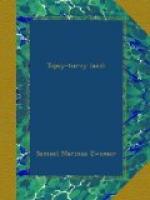The Shepherd of the Machine kept working away and when his hopes grew strong he sang at his work. In a few months he paid a visit to the Mullah (the Moslem priest or teacher), and that same night the Arab fiddles and drums rang out merry music around the palm-leaf hut of his beloved bride. But the music of the machine sounded still sweeter next morning. Daily bread, with rice, fish and dates, and on rare occasions even mutton, all came out of the machine. He loved the very iron of it and, as he told us, read a prayer over it every morning: Bismillahi er rahman er raheem. His was the only machine, and a small monopoly soon makes a capitalist. His palm branch hut was exchanged for a house of stone; and Allah blessed him greatly. No shepherd was ever more tender to his little lambs than Mohammed to the old machine.
When we entered the house on our first visit, there stood the machine! Not much the worse for wear, and with “Pfaff. C. Theodosius, Constantinople,” still legible on the nickel-plate. But the old machine had found a rival. By its side stood another make of machine which looked strangely familiar to American eyes. It was while comparing the machines and drinking Arab coffee that we learned from Mohammed why he prized the old one as better. “Wallah,” he said, “I would not sell it for many times its original price. There is blessing in it, and all I have comes from that machine, praise be to Allah.” And so we sipped his cups and heard his story and ceased to wonder why he was called the Shepherd of the Sewing machine. The shepherd has a brother who wants to learn English and goes to Bombay every year—but that is another story.




